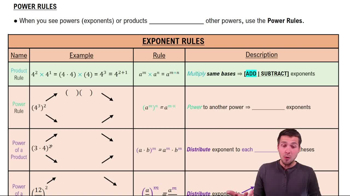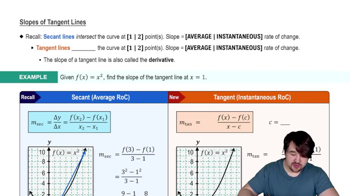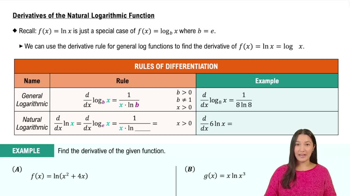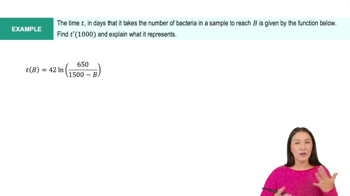Table of contents
- 0. Functions7h 52m
- Introduction to Functions16m
- Piecewise Functions10m
- Properties of Functions9m
- Common Functions1h 8m
- Transformations5m
- Combining Functions27m
- Exponent rules32m
- Exponential Functions28m
- Logarithmic Functions24m
- Properties of Logarithms34m
- Exponential & Logarithmic Equations35m
- Introduction to Trigonometric Functions38m
- Graphs of Trigonometric Functions44m
- Trigonometric Identities47m
- Inverse Trigonometric Functions48m
- 1. Limits and Continuity2h 2m
- 2. Intro to Derivatives1h 33m
- 3. Techniques of Differentiation3h 18m
- 4. Applications of Derivatives2h 38m
- 5. Graphical Applications of Derivatives6h 2m
- 6. Derivatives of Inverse, Exponential, & Logarithmic Functions2h 37m
- 7. Antiderivatives & Indefinite Integrals1h 26m
- 8. Definite Integrals4h 44m
- 9. Graphical Applications of Integrals2h 27m
- 10. Physics Applications of Integrals 2h 22m
6. Derivatives of Inverse, Exponential, & Logarithmic Functions
Derivatives of Exponential & Logarithmic Functions
Problem 87d
Textbook Question
Determine whether the following statements are true and give an explanation or counterexample.
d/dx((√2)x) = x(√2)x - 1
 Verified step by step guidance
Verified step by step guidance1
Step 1: Recognize the function given is \( f(x) = (\sqrt{2})^x \). This is an exponential function where the base is \( \sqrt{2} \).
Step 2: Recall the derivative rule for exponential functions of the form \( a^x \), which is \( \frac{d}{dx}(a^x) = a^x \ln(a) \).
Step 3: Apply the derivative rule to \( f(x) = (\sqrt{2})^x \). The derivative is \( (\sqrt{2})^x \ln(\sqrt{2}) \).
Step 4: Compare the derived expression \( (\sqrt{2})^x \ln(\sqrt{2}) \) with the given expression \( x(\sqrt{2})^{x-1} \).
Step 5: Conclude that the given statement is false because \( (\sqrt{2})^x \ln(\sqrt{2}) \neq x(\sqrt{2})^{x-1} \). The correct derivative involves the natural logarithm of the base, not a multiplication by \( x \).
 Verified video answer for a similar problem:
Verified video answer for a similar problem:This video solution was recommended by our tutors as helpful for the problem above
Video duration:
2mPlay a video:
Was this helpful?
Key Concepts
Here are the essential concepts you must grasp in order to answer the question correctly.
Derivative of Exponential Functions
The derivative of an exponential function of the form a^x, where a is a constant, is given by d/dx(a^x) = a^x * ln(a). This rule is essential for differentiating functions where the base is a constant raised to a variable exponent, such as (√2)^x.
Recommended video:

Derivatives of General Exponential Functions
Power Rule
The power rule states that if f(x) = x^n, then f'(x) = n*x^(n-1). This rule is commonly used for differentiating polynomial functions and is not applicable to exponential functions where the base is a constant.
Recommended video:
Guided course

Power Rules
Counterexamples in Mathematics
A counterexample is a specific case that disproves a general statement. In this context, providing a counterexample to the statement d/dx((√2)^x) = x(√2)^(x - 1) would involve showing that the left-hand side does not equal the right-hand side for any value of x, thus demonstrating the statement's falsehood.
Recommended video:

Slopes of Tangent Lines

 4:50m
4:50mWatch next
Master Derivatives of General Exponential Functions with a bite sized video explanation from Callie
Start learningRelated Videos
Related Practice













